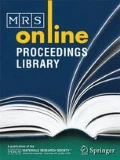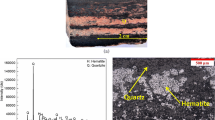Abstract
There are plentiful of oolitic iron ore resources on the earth, which cannot be currently exploited because of great difficulties for beneficiating the ore. In this work, the selective fragmentation of a Chinese oolitic iron ore (which fragments ore particles along the interfaces of iron and gangue minerals) through microwave was studied in order to liberate the iron minerals at a coarse particle size and thus to effectively concentrate the iron minerals from the ore. The experimental results have shown that a large amount of fractures on the oolitic iron ore were formed along iron and gangue mineral interfaces after being treated by microwave radiation at an appropriate frequency and potential. Following a microwave treatment, the oolitic iron ore was ground by using a ball vertimill. It was indicated that the pretreatment increased the liberation of the iron and gangue minerals at the same particle size, about 10-20% and 10-30% respectively.
Similar content being viewed by others
References
Fuerstenau D.W., Chander S., Abouzeid A.M., (1979), Beneficiation of Mineral Fines: Problems and Research Needs, P. Somasundaran and N. Arbiter (Ed.), National Science Foundation, 3–59
Song S., Lu S., Lopez-Valdivieso A., (2002), Magnetic separation of hematite and limonite fines as hydrophobic flocs from iron ore, Minerals Engineering, 15, 415–422.
Fitzgibbon K., Veasey T., (1990), Thermally assisted liberation a review, Minerals Engineering 3, 181–185.
Jones D.A., Kingman S.W., Whittles D.N. Lowndes I.S., (2005), Understanding microwave assisted breakage, Minerals Engineering 18, 659–669.
Wang G., Radziszewski P., Ouellet J., (2008), Particle modeling simulation of thermal effects on ore breakage, Computational Materials Science 43, 892–901.
Rasband, W.S., (1997-2009), ImageJ, U.S. National Institutes of Health, Bethesda, Maryland, USA, http://rsb.info.nih.gov/ij/.
Whittles D.N., Kingman S.W., Reddish D.J., (2003), Application of numerical modeling for prediction of the influence of power density on microwave-assisted breakage, International Journal of Mineral Processing 68, 71–91.
Salsman J.B., Williamson R.L., Tolley W.K., Rice D.E., (1996), Short pulse microwave treatment of disseminated ores, Minerals Engineering 9, 1 43–54.
Ali A.Y., Bradshaw S.M., (2009), Quantifying damage around grain boundaries in microwave treated ores, Chemical Engineering and Processing 48, 1566–1573.
Acknowledgment
The financial supports for this work from the Consejo Nacional de Ciencia y Tecnología (CONACyT) of México under the grants No. 48436-Y, No. 92506 and No. 123487 are gratefully acknowledged.
Author information
Authors and Affiliations
Rights and permissions
About this article
Cite this article
Campos-Toro, E.F., Song, S. & López-Valdivieso, A. Selective Fragmentation of Oolitic Iron Ores by Microwave Pretreatment. MRS Online Proceedings Library 1380, 5 (2011). https://doi.org/10.1557/opl.2012.401
Published:
DOI: https://doi.org/10.1557/opl.2012.401




